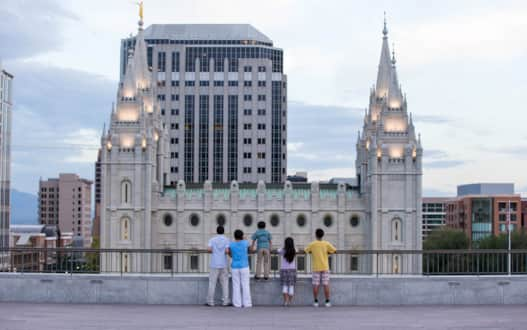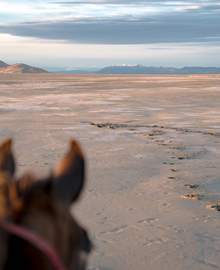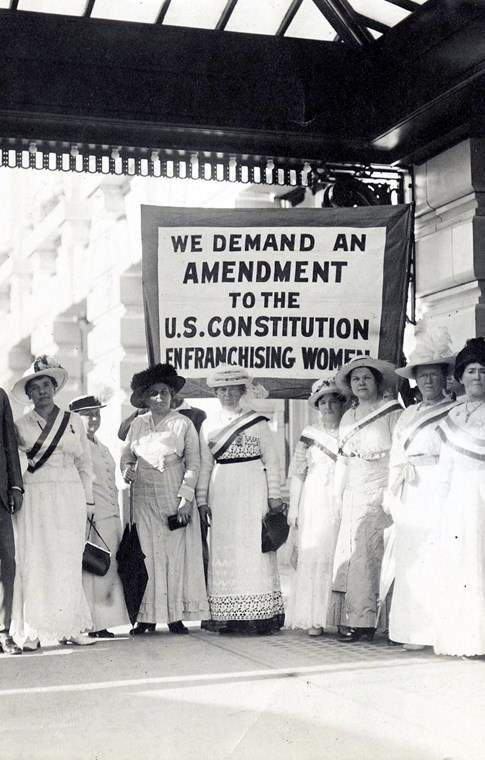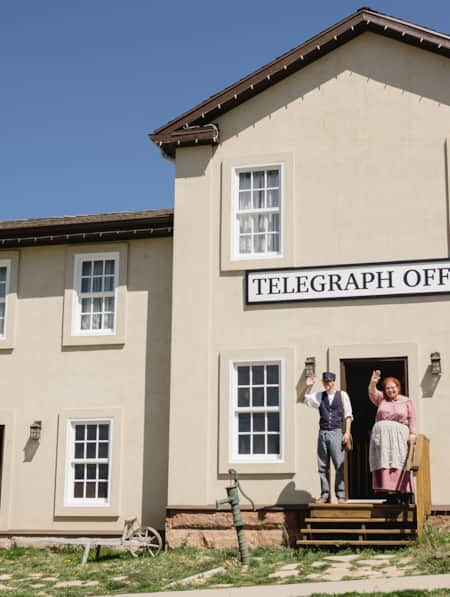10 Places to Honor Women's History on Your Trip to Utah
Notable places you can visit where women have shaped history

There are a lot of impressive places to visit in Utah, which can sometimes make it hard to decide where exactly to go for the weekend or during a vacation. With it being the 100th Anniversary of the passing of the 19th amendment, and considering Utah women were the first women in the nation to cast a ballot, there is every reason to plan your trip this year around honoring the lives of Utah women. From the Native American tribes to pioneers, women have been shaking things up and leading progress and change in Utah for centuries.
Listed below are 10 notable places you can visit in Utah where women have shaped history.
1. Temple Square
Utah women played a major role in the national suffrage movement during the early 20th century. Utah women received the right to vote in 1870. The following year, Susan B. Anthony and Elizabeth Cady Stanton, two prominent leaders of the national suffragist movement, visited Utah.
Both Susan B. Anthony and Elizabeth Cady Stanton spoke to a large gathering of Utah women at the old Salt Lake Tabernacle inside Temple Square. Though this building was torn down, Temple Square is still a National Historic Landmark and many of the other buildings that were there then can still be seen today.
After her visit to Utah, Susan B. Anthony developed a close friendship with several women from Utah, including one of Utah’s most well-known suffragists, Emmeline B. Wells. To thank Anthony for her speech, a group of women sent her a bolt of black silk produced by the women-owned silk industry. From that silk, Anthony made a dress that can still be seen on display inside her home in Rochester, New York. (Read: "Utah’s Women Make History")

An overlook to Temple Square.
Photo: provided by Temple Square

Bear River Migratory Bird Refuge.
Photo: Marc Piscotty
2. Bear River Migratory Bird Refuge
Home to more than 200 bird species, including North America’s largest pelican colony, the Bear River Migratory Bird Refuge is an environmental gem in Northern Utah that often gets overlooked. Established in 1928, the refuge now offers more than 74,000 acres of wetland habitat for native wildlife.
This is also a favorite place in Utah for the famous environmental writer Terry Tempest Williams. She wrote one of her most popular memoirs, Refuge, about this location in contrast with her relationship to her mother, grandmother and their shared history.
You can stop by the refuge and visit the new education center, or drive the 12-mile auto tour to see the birds and revel in the abundance of untouched, pristine flora and fauna throughout the area.
3. Josie Bassett Morris’ Cabin
Josie Bassett Morris was a legendary woman, who grew up on the Colorado–Utah border during the Wild West’s heyday. Josie and her sister Ann are known for having been close friends with outlaw Butch Cassidy’s Wild Bunch, for rustling cattle, and for being some of the only women ever allowed inside the Wild Bunch’s hideout in Southern Utah, Robbers Roost. (Read: In Search of Robbers Roost)
In her later years, she purchased land inside of what is now Dinosaur National Monument. Her property backs up into a slot canyon and skirts the Green River. The land is the only known home of a rare orchid breed, and can be seen bursting with wildflowers in the spring.
Onsite, her log cabin, where she lived without plumbing or electricity until her death in 1964, is still standing. You can walk the property and also see pieces of her old gardening equipment, her orchard, and even remnants of the pens where she kept her animals.

Josie Bassett Morris by her cabin. Used by permission, Uintah County Library Regional History Center, all rights reserved.

The legendary Josie Bassett Morris. Used by permission, Uintah County Library Regional History Center, all rights reserved.
4. Council Hall in Salt Lake City
This is a unique building in Salt Lake City to stop by, while spending time on Capitol Hill and the nearby Memory Grove. In 1870, this building was where the Utah Territorial Legislature (as Utah was not yet an official state, but a territory) voted to give women the right to vote, making Utah the second state to give women the right to vote.
Two days after the vote was expanded, Utah women were the first in the country to participate in an election, also held in the Council Hall building. It was a municipal election, and a local school teacher Seraph Young was the first to officially cast a ballot.
The building was moved from its original location in 1961, but reconstructed using all the original materials. Inside, there’s an artistic and historical display honoring the first election. On the front lawn, a sculpture called "A Path Forward" traces the nation’s movements toward equal suffrage rights, and Utah’s contribution to that cause.

Council Hall, where the Utah Territorial Legislature voted to give women the right to vote.
Photo: Matt Morgan
5. Horne Fine Art Gallery
Today the Horne Fine Art Gallery in Salt Lake City showcases the work of Karen Horne and her mother Phyllis Horne, alongside a wide range of classic and contemporary artwork produced by artists from all over the world. Recently Karen was honored by being named one of the “Most Honored Artists of Utah.”
The legacy for contributing to the arts goes back a few more generations. Karen’s great-grandmother, Alice Merrill Horne ran for the 3rd Utah Legislature, specifically with the intent to advance the arts in Utah. She was elected and was responsible for writing the legislation that created the Utah Arts Council. This was the first state sponsored arts agency in the United States. Alice also wrote legislation that set aside a land grant for the University of Utah, established a state art collection, which now boasts over 1200 pieces, and organized ongoing exhibitions.
The Horne Fine Art Gallery is open in the afternoon and early evenings Tuesday through Saturday. While visiting you can also swing by Fisher Brewing or Ruby Snap which are located just down the street. (Read: Rediscovering a Piece of Utah’s History at A. Fisher Brewing Company)

An actor spinning wool at This is the Place Heritage Park.
Photo: This is the Place Heritage Park
6. This is the Place Heritage Park
This is the Place Heritage Park is a great place to get a look at the way that native and early pioneer women in Utah lived their lives.
You can walk through the Heritage Village, which features a replica Native Village. A bonus is that the Native Village is actually run by a Navajo woman, Meredith Lam. This area also has replicas and relocated historic pioneer buildings, including the Desert Hospital and Quilt Museum. It isn’t well known that Utah women were not only the first to vote, but also some of the first to receive medical licenses. Brigham Young sent women to schools in the east in an effort to improve the Utah Territory’s health care access.
At the Heritage Village you can also walk through replicas of the homes of pioneer women like Margaret Hickman and Mary Fielding Smith. After your long walk, you can go for a guided horseback ride to one of the vistas overlooking the city. A visit here really makes for an excellent way to pay homage to the many women who paved the way in Utah.
7. Heritage House Museum in Kanab
In 1911 the first all women city council in Utah was elected in Kanab for the 1912-1913 term. Mary Elizabeth Woolley Chamberlain served as mayor of Kanab and presided over the council. She was Utah's first female mayor, and the fourth female mayor in the United States. The five women who made up the council were elected without actually running. Some people claimed it was a joke, but the women accepted the positions regardless and got to work passing new laws and working for the residents of this Southern Utah town.
While visiting Zion National Park, Grand Staircase Escalante, or Monument Valley, it is worth stopping by this charming town near the Utah-Arizona border (Read: The Creature Comforts of Kanab). You can visit the Kanab Heritage House, which is listed on the National Register of Historic Places. The house was built in 1894, and served as a residence for many prominent families in Kanab over the years.
Today the Heritage House is a museum, with guided and self-guided tours showcasing the history of Kanab. You can see a photo of the all women council in the home, and guides share the story about how they became Utah’s first all women city council.

Members of the Ladies' Town Board in Kanab, Utah. Central figure is Mary Howard (Chamberlain, Mary E. Woolley, 1870-1953). Used by permission, Utah State Historical Society.

The first all women city council in Utah was elected in Kanab for the 1912-1913 term at the Heritage House. Photo provided by Kanab Heritage House Museum
8. Sanpete Valley
Spring City and Ephraim in the gorgeous Sanpete Valley are home to two sites important to women’s history in Utah. Best of all, you can easily visit them both in a day.
In Ephraim the restored pioneer-ara Granary building houses Granary Arts, which features rotating displays of artwork created by Utah artists. Next door at the [co-op], you can also purchase local food and handmade goods, a lot of which are made by women in the area. Both of these buildings were restored thanks to advocacy from local women, as a way to honor the pioneer women who once ran the old granary. Stop by to pay tribute to the enduring culture and history that has been passed down to women in Ephraim for generations. (Read: Gleaning a Small Town’s Harvest)
Spring City is a town near Ephraim in the Sanpete Valley, and is one of only two entire cities in the United States to be listed on the National List of Historic Places. The other is Colonial Williamsburg in Virginia. This was home to the beloved artist Ella Peacock, who holds the nickname “Matriarch of Utah artists.” She and her husband moved to Spring City in the 1970s. Ella’s renowned oil paintings, known for their muted blue, grey and green tones, hang in galleries throughout the state as well as in Philadelphia and San Francisco. You can stop by the Spring City Arts Gallery to see a selection of work by Ella and other local artists who were artistically inspired by the area. Pro-tip: don’t miss sister-owned restaurant Das Cafe down the street. (Read: Utah's Taste of Germany)
9. Hotel Utah
Hotel Utah is one of downtown Salt Lake City’s most iconic buildings. It is important to note that women in Utah originally gained the right to vote in 1870. Like the Nineteenth Amendment, this right to vote still did not extend to Native American women and women of color. Becuase the initial right to vote for Utah women was heavily wrapped up with questions surrounding the practice of polygamy within the territory, the right to vote was then revoked in 1887.
In 1915, suffragists made their way to the hotel in a motorcade to meet with Utah Senator Reed Smoot. It was part of suffragist, Alice Paul’s, western tour, and an attempt to convince Senator Smoot to support the suffrage movement.
Room 834 within the hotel was also the home of prominent Utah suffragist Emmeline B. Wells between 1916 and 1921. President Woodrow Wilson and his wife stayed in the hotel to visit her in 1919.
Hotel Utah is no longer a hotel, and is now owned by The Church of Jesus Christ of Latter-day Saints and referred to as the Joseph Smith Memorial Building. It is still fun to walk through, featuring original, ornate decor and a restaurant on one of the top floors offering a bird’s eye view of the city.
Read "Utah’s Unexpected Pit Stops" to learn of more unique stops to make on your next road trip

Spring City is a town near Ephraim in the Sanpete Valley, and is one of only two entire cities in the United States to be listed on the National List of Historic Places.
Photo: Austen Diamond

A Navajo woman weaves something of beauty in Monument Valley.
Photo: Barry Gutierrez
10. Monument Valley
Monument Valley is arguably one of the most iconic destinations in the American West. Known by the native Navajos as Tse’Bii’Ndzisgaii, this area often brings to mind images of cowboys, is regularly featured in western films, and is also easily one of the most photographed places on earth. These stories often revolve around men, but women have made history here too.
Louisa Mary Wade Wetherill ran a trading post in Ojita near Monument Valley in the early 1900s. Here, Louisa befriended members of the local Navajo tribe and learned to speak their language fluently. She recorded their stories, sharing them with other white settlers in the region to promote appreciation for the Navajos’ ancient culture within the region.
This is also where famous photographer, Cindy Sherman, shot one of her most iconic photographs, Monument Valley Girl. Sherman was known for dressing up and taking images that were set up to comment on the landscape in which they were taken. This photo was a deliberate move to insert women into the western narrative. She offered viewers of her work a fresh lens through which to consider women and their relationship to the environment and our shared cultural mythologies.
Today in this area, many Navajo women share their stories and traditions as guides and artists. (Watch: Navajo guide Carol Talus in the Voices of Bears Ears series)





































